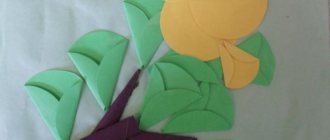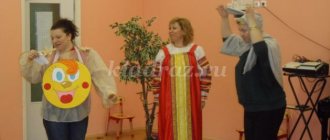"The Magic World of Checkers"
This game also develops in children qualities that are important for their future life, such as the ability to think independently and bear responsibility for decisions made, and to deal adequately with failures and defeats. Moreover, work in a circle involves joint activities of children, which improves communication skills, fosters a friendly attitude of children towards each other, thereby creating a favorable emotional background in the group.
I recommend starting to teach children how to play checkers in the senior group of kindergarten (from 5 years old). It is at this age that children’s attention becomes more stable and voluntary, and the prognostic and visual-imaginative functions of thinking
, which allow us to solve more complex problems. By the age of five, children become more diligent (they can engage in one activity for 20–25 minutes) and are able to play according to established rules.
When learning to play checkers, first of all, it is important to know that children should never be forced, they must want it themselves. In the group there will always be active and curious children who love “something new”; first they get involved in the work, then other children, looking at them, also begin to get involved in playing checkers.
The main thing is that the learning process for children is unobtrusive and interesting. It is necessary to introduce children to material that is new to them in a simple and very accessible form for them to understand. For example, you can tell children about the rules of the game of checkers in the form of a fairy tale or in a poetic version, which, having memorized, children will quickly begin to navigate them and stop getting confused (the most common mistake is moving back with a simple checker in the absence of “safe” moves forward).
The rules of the game of checkers at first glance seem simple, but, as my experience of working with children shows, to play checkers it is not enough just to know the rules, since this game contains many different kinds of difficulties, subtleties and intricacies. In order for children to learn how to play checkers well, they need systematic lessons that contain a minimum of theory and a maximum of practice.
Introducing and teaching children to play checkers occurs in stages, according to the principle: from simple to complex
. First, children need to be introduced to the history of this game, then shown the board, black and white chips, and then taught how to correctly place checkers on the playing field, explain why all checkers are placed only on dark squares (this is necessary so that opponents’ checkers met in the game) and so on. It is also necessary to clearly formulate the essence of the game, which is to, when moving your checkers forward, destroy your opponent’s checkers or block all his moves. After children have learned general information about checkers, they can begin to learn the basic rules of the game. I offer my own poetic version, which greatly helps children quickly master the rules of this smart game.
Annual plan for a board games club. “Miracle of Checkers”, “Tyryynka” Senior preparatory group. on the city
Transcript
1 Municipal budgetary preschool educational institution General developmental kindergarten “Sun”. Approved From 2021 Head: Nikitina S.P. Annual plan for the circle board games “Miracle Checkers”, “Tyryynka” Senior preparatory group. on the city. Head: Cherkashina G.N. There are 5 children in school.
2 Work plan for the circle “Miracle Checkers”, “Tyryynka” Explanatory note. “Miracle Checkers” The types of games for children are very diverse. In kindergarten, games are used that are designed specifically to develop children's mental abilities, improve and train their memory and thinking. One such game is the game “Checkers”. Checkers is an exciting game that develops perseverance and the ability to concentrate, and trains mental flexibility. The rules of the game are simple, as long as you don't turn it into a boring game. Getting to know the unique world of checkers will help prepare the child’s mind to perceive abstract logical categories. Enthused by the “battle,” a child in the “Land of Checkers” will be able to force himself to sit still and try to focus his attention on the events taking place on the board. A cognitive-speech club with the integration of educational areas: cognitive development, speech development, physical education, artistic and aesthetic development, social and communicative development, for children aged 5-6 years. Board game of the Sakha people “Tyryynka” - board games reflect the traditions, lifestyle, and way of life of the Sakha people. - they develop flexibility of fingers and hands, dexterity, coordination, resourcefulness and mental abilities. -they contribute to the transfer of vital skills, education of morality, respect for folk traditions and customs. - advantage: both children and adults play, the material and production of equipment is accessible to everyone, environmentally friendly. — folk board games are the best way for children and parents to spend their leisure time together. Goal: Teaching preschoolers the principles of the game, instilling in them an interest and love for these games, preparing students for further stages of development. Get children interested and interested in board games. Objectives: Educational: - teach the basics of board games; — teach simple combinations, theory and practice of the game.
3 Educational: - to cultivate an attitude towards games as serious, useful and necessary activities that have a sporting and creative orientation; — to cultivate: perseverance, determination, resourcefulness, attentiveness, self-confidence and the ability to overcome difficulties; - develop in children the ability to apply acquired knowledge in practice. — fostering respect and love for Yakut board games; Developmental: - develop children’s desire for independence; - develop the mental abilities of children: logical thinking, the ability to make calculations several moves ahead, development of fine motor skills. Physical: - carry out the comprehensive physical development of children. The main forms of work and means of teaching are: - practical games; - solving problems, combinations; — didactic games and tasks, game exercises; - entertainment, educational leisure, games of checkers and Tyryynka. Expected results: - play board games "checkers", "Tyryynka" - the rules of the move, navigate on the checkers board - solve simple checkers problems - knowledge of the basics of board games - perform technical techniques of the game "Tyryynka" Organizational and methodological instructions for conducting club classes " Miracle of Checkers", "Tyryynka". — Classes are held once a week, in the afternoon, for a minute at a time, and consist of three parts: introductory, main, final. — Classes on the Yakut folk game “Tyryynka” are held at the end of each month. — Before educational activities, a sedentary game is played.
4 - Activities in the game gradually become more difficult. Handouts: checkers boards and sets of checkers, sticks for the game Tyryynka Involve a circle of parents in the work to make attributes. Work with parents: Introduce parents to the circle program. Conduct a survey of parents on the topic “Playing checkers with children.” Update checker boards and sets of checkers, sticks for the game "Tyryynka" Help for parents in making checker boards, pieces for the game (together with children), sticks. List of students: 1. Pudov Albert Struchkov Arthur Sosin Pasha Pavlova Regina. 5. Cherkashina Veronica. Long-term planning of the work of the “Miracle Checkers” circle “Tyryynka”. Goal: to teach children how to handle a chessboard, pieces, to teach games of “Checkers”, “Corners”, “Giveaway”, to teach children to use terms when playing; cultivate perseverance, curiosity, the ability to win and be defeated, develop logical thinking, fine motor skills, movement coordination, ingenuity, and dexterity. September Introduction to Horizontal. chessboard. Introduction to the game of the Sakha peoples “Tyryynka”. Preparing a play area for children. Goal: to teach children how to handle the chessboard and pieces. Goal: To teach how to fill one of the horizontal lines of a chessboard Goal: To teach children the rules of handling sticks. Goal: creating conditions. Learning finger gymnastics with
5 boards with cubes (chips). using sticks to play. October "Vertical". “Diagonal”. Definition Teach children long and short independently and from diagonals. pleasure to play. Goal: To teach how to fill one of the vertical lines of the chessboard with cubes (chips). Goal: development of abilities. Learning moves during the game. November Introduction to checkers pieces. Initial arrangement of pieces Learning to play. Moves and capture of pieces. Explanation of the position in the game. Game with rivals. Goal: To encourage the ability to independently place pieces in the starting position, determine the direction of moves.. Goal: To introduce the rules of moving and capturing pieces. Goal: continue to teach how to play the game “Tyryynka”. Goal: to cultivate perseverance, curiosity, the ability to win and be defeated, develop logical thinking, fine motor skills. December Tasks and tasks developing logical thinking. rivals. rivals. Checkers competitions and “Tyryynka” for a sweet prize.
6 Goal: developing the ability to reason logically, generalize your knowledge... Goal: provide the opportunity to choose a game according to your wishes. January Introduction to the game of giveaway. Continued acquaintance with the games of the peoples of Sakha. children and adults (educators). Goal: teach games of “Giveaway” Goal: development of abilities. February Who lost, won. rivals to rivals. Game with rivals. "Checkers" and "Giveaways". Goal: Continue to practice the rules of giving, the desire to overcome difficulties, and self-confidence. Goal: to consolidate the skills of playing “Checkers” and “Giveaway”. Goal: to cultivate perseverance, curiosity, the ability to win and be defeated, develop logical thinking, fine motor skills. March Educational games. Demonstration and training of the game “Corners”. Goal: Continuation and training of Yakut games. rivals
7 formation of the ability to reason logically and generalize one’s knowledge. Goal: introduction to a new game, development of abilities in children. Goal: introduction to the new game “Habylyk” - sticks, development of abilities in children. April Competition game "Giveaway" 1st round Competition game "Corners" 2nd round with rivals. Goal: to cultivate perseverance, curiosity, the ability to win and be defeated, develop logical thinking, fine motor skills. rivals Goal: develop children's abilities, cultivate perseverance and curiosity May Checkers competition 1st round Goal: teach children to use terms when playing, cultivate perseverance Competition in the board game "Tyryynka" 1st round Game "Tyryynka" with parents. Goal: developing communication skills, the desire to overcome difficulties, and self-confidence.
8 Yakut board game “Tyryynka” for children of the senior group Relevance: - board games reflect the traditions, lifestyle, and way of life of the Sakha people. - they develop flexibility of fingers and hands, dexterity, coordination, resourcefulness and mental abilities. -they contribute to the transfer of vital skills, education of morality, respect for folk traditions and customs. - advantage: both children and adults play, the material and production of equipment is accessible to everyone, environmentally friendly. — folk board games are the best way for children and parents to spend their leisure time together. 1. Topic: Yakut board game Tyryynka (pulling out splinters one at a time). Goal: 1. To introduce children to the Yakut board game Tyryynka Objectives: 1. To teach children to play independently and with pleasure. 2. Develop attention, thinking and dexterity in children. 3. Attract and interest children and parents in the board game Tyryynka. — Main stage: 1. Introduction to the rules of the Tyryynka game 2. Learning finger gymnastics using playing sticks. 3. Come up with and put together a game - making up figures using sticks for the game Tyryynka 4. Life safety rules for handling sticks. 5. Round table for parents Tyryynka Sakha trt oonnyuulara 6. Making attributes for the game Tyryynka 7. Competition between children.
9 Expected result: - As a result of the work, the knowledge and interest of children and parents in the Kyakut board game Tyryynka will expand. — Children will master the technique of playing Tyryynka — For each child, parents will make a set of sticks for the game. Literature: “Adventures on the checkers board” -L.; Leninzdat, 1969, “Learning to play checkers” - Vasilevsky R.G. Kyiv: Health, 1985, “Book about checkers” - Gorodetsky B.G. M.: Physical education and sports, “Checkers is interesting” - Gertsenzon B., Napreenkov A. St. Petersburg; Litera, 1992 Dvorsportinfo.ru, ynqa.ucoz.ru - Tyryynka.



